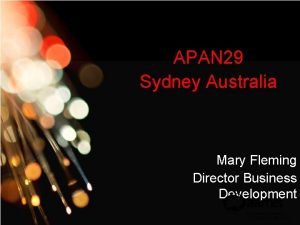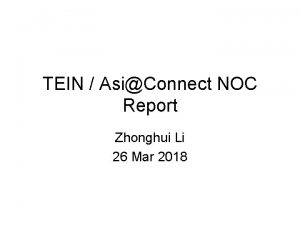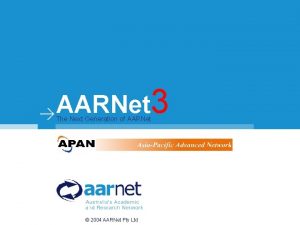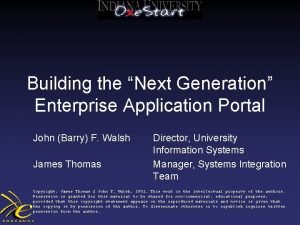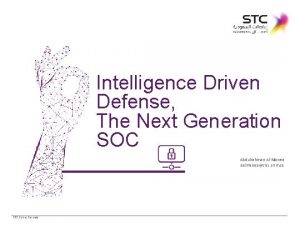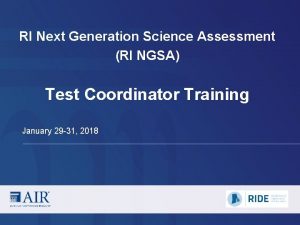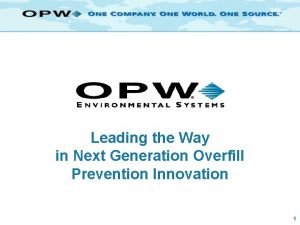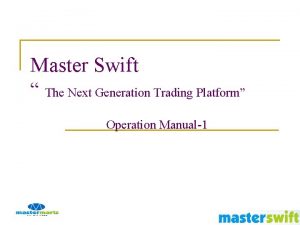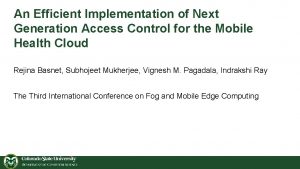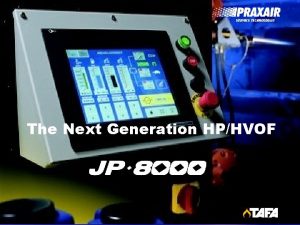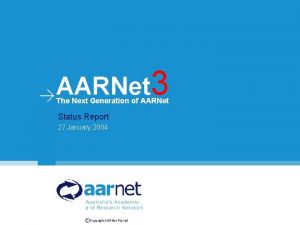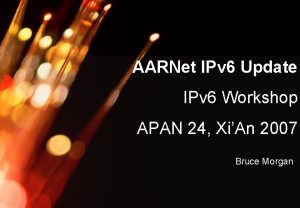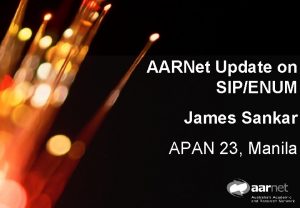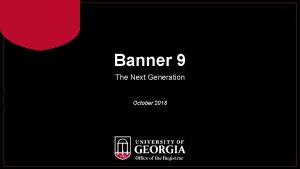AARNet 3 The Next Generation of AARNet 2004




























- Slides: 28

AARNet 3 The Next Generation of AARNet © 2004 AARNet Pty Ltd

Background to AARNet • AARNet Pty Ltd (APL) is a not for profit company owned by 37 Australian Universities and the Commonwealth Scientific & Industrial Research Organisation (CSIRO) • Operates a national network providing commodity and research Internet access to members and clients • Clients include Defence Science and Technology Organisation (DSTO), National Library of Australia, Australian Institute of Marine Science • Current network deployed in 1997, based on ATM mesh between state and territory networks (RNO) • Also operates a STM-1 ring to the USA (Hawai‘i and Seattle) on Southern Cross, primarily for research but some commodity via Pacific Wave • Currently buys commodity access at each RNO from Optus or Telstra © 2004 AARNet Pty Ltd 2

Design Issues • Redundancy & Resilience • Support for IPv 4 and IPv 6 – unicast and multicast • Traffic Accounting and Monitoring • End to end performance measures • Support Qo. S (diffserv) • Support for large traffic flows, jumbo frames © 2004 AARNet Pty Ltd 3

Redundancy & Resilience • Dual points of presence (POP) in major capital cities • Diverse, dual unprotected national links – Will use MPLS Fast Reroute for protection – Provides ability to burst above capacity • Use single metro dark fibre pair to connect intra city POP sites • Creates rings between cities • Provides opportunity for members and customers to build diverse, redundant connections to AARNet © 2004 AARNet Pty Ltd 4

Australian Network © 2004 AARNet Pty Ltd 5

10 Gbps Backbone • Provided on the “Nextgen Networks” network • Two fibre pairs on each path – STM-64 service provided on first pair for inter capital trunks – Second pair may be lit with CWDM to allow Gigabit Ethernet drop off to regional members, other solutions to be considered – Member must provide tail to the regional network © 2004 AARNet Pty Ltd 6

Member Connections • Diverse connection to each POP – Two diverse, independent links, one to each POP • Dual connection connecting each POP – Two links over same infrastructure to single POP – AARNet trunks one link to the second POP though switches • AARNet provided diversity – Single link to one POP, AARNet provides LAN linking both AARNet POP sites and the member © 2004 AARNet Pty Ltd 7

Connections through the Giga. POPs © 2004 AARNet Pty Ltd 8

Trans Pacific Transmission • “SX Trans. PORT” - Dual STM-64 (10 Gbps) – Hawai‘i - Manoa and Seattle (Abilene, CA*net 4) – Los Angeles (Abilene, CENIC, CUDI) – Look to add Mauna Kea to Los Angeles path later • Dual STM-4 (622 Mbps) for commodity Internet – PAIX Palo Alto (Silicon Valley) – Los Angeles • Add drop offs to existing STM-1’s (155 Mbps) – University of South Pacific, Fiji – Possibly Auckland, New Zealand – Connects to 155 Mbps path to Tokyo from Hawai‘i © 2004 AARNet Pty Ltd 9

AARNet’s Pacific Ocean links © 2004 AARNet Pty Ltd 10

Equipment • Core Router – 40 Gbps capable – Redundant power but not CPU – Packet over SDH to STM-64 (roadmap to STM-256) – Gigabit and 10 Gigabit Ethernet • Core Switch – Pure L 2 switching – Fast, Gigabit and 10 Gigabit Ethernet only • Member Edge and POP based “Legacy” routers – 3 x Gigabit Ethernet (Member, POP “A”, POP “B”) – 1 x Fast Ethernet dedicated to flow accounting – Capability to handle legacy (slow) interfaces © 2004 AARNet Pty Ltd 11

Backbone Routers - Procket 8812 • • 22 RU (95. 3 x 44. 2 x 64. 8 cm) 12 Line Cards 48 Media Adapters (MA) Route Processor – Procket developed System Control Chip – 500 MHz IBM Power PC – 2 GB main memory – 512 MB Compact Flash (system program storage with redundant images) – 20 GB Hard Disk Drive (system log files) – 960 Gbps 1. 2 Bpps • • © 2004 AARNet Pty Ltd 12 1 Port STM-64 MA 1 Port 10 Gigabit Ethernet MA 10 Port Gigabit Ethernet MA 8 Port STM-1/STM-4 MA

Pro/8812 under test • Sitting in the Nextgen node room in Adelaide • Testing the STM-64 circuit between Adelaide and Perth • 32 Kbyte Packets ‘back-toback’ at 10 Gbps © 2004 AARNet Pty Ltd 13

Core Backbone Switches - Cisco 6509 • 20 RU (84. 4 X 43. 7 x 46. 0 cm) • 9 Slot Chassis • Supervisor 720 – 720 Gbps – 30 Mpps Centralized, up to 400 Mpps for CEF 720 interface modules equipped with d. CEF (DFC 3) or a. CEF daughter cards • 4 port 10 Gigabit Ethernet • 48 port 10/1000 UTP based Ethernet • 24 port SFP Gigabit Ethernet • Potential for service modules later © 2004 AARNet Pty Ltd 14

Edge Routers - Cisco 7304 • 4 -RU (10 cm) compact chassis • 4 -slot modular system • Network Equipment Building Standards (NEBS) Level 3 compliance • NPE-G 100 Processor – Three onboard Gigabit Ethernet ports – 1 GB of Synchronous Dynamic RAM (SDRAM) – 256 MB of removable Compact Flash memory – Better than 1 mpps processing performance • Redundant power supplies • Front-to-back airflow for optimal cooling © 2004 AARNet Pty Ltd 15

IPv 4 and IPv 6 • Native IPv 4 and IPv 6 (Dual Stack) network – Unicast and Multicast for both IPv 4 and IPv 6 – EFT IPv 6 Multicast (initially intra-domain only) – Line rate performance for IPv 4 and IPv 6 – Peering to both R&E and Commodity Internet w/ IPv 6 – Hexago IPv 6 Migration Broker to aid member and client IPv 6 deployment • DNS, AARNet Mirror and USENet News accessible over IPv 4 and IPv 6 • IPv 6 Performance Measurement • IPv 6 Flow Records? • Jumbo frames, 9000 byte © 2004 AARNet Pty Ltd 16

Some Issues • End to end performance measures – Desire to measure performance from member site – Provide connectivity reports on core services • Support Qo. S (diffserv) – Need to support Vo. IP and Video. IP traffic – Possibly introduce scavenger service • Support for large traffic flows, jumbo frames • Support for EVERYTHING with IPv 6? © 2004 AARNet Pty Ltd 17

Services • • DNS Cache and Secondary Servers Usenet News Hexago IPv 6 Migration Broker DDo. S Detection and Mitigation – Investigate appliances – Interest in automatic detection and filtering – Locate next to transit (and peering) links – IPv 6 Do. S/DDo. S? • AARNet Mirror • Vo. IP Gateways • NLANR and/or RIPE Test Traffic Measurement © 2004 AARNet Pty Ltd 18

Current Status (1) • National Transmission – Confirmation of POP sites – Testing STM-64 circuits – Build new Giga. POP sites – Obtain fibre between Giga. POPs and COs – Solution for Tasmania and Northern Territory • International Transmission – Planning progressing with US partner organisations on connecting “SX Trans. PORT” – STM-4 to Palo Alto should be enabled during February – Direct Asian links dependant on available funds and member demand © 2004 AARNet Pty Ltd 19

Current Status (2) • Commodity Internet Transit – Access Commodity Internet in Palo Alto • Connected to the PAIX fabric • Obtain transit from MCI/UUnet and NTT/Verio – Commodity IPv 6 Transit! • Peer with other organisations at PAIX – Add second commodity POP in Los Angeles • Need to determine – data centre location – backhaul from Morro Bay (San Luis Obispo) • Will use the same transit providers as at Palo Alto © 2004 AARNet Pty Ltd 20

Current Status (3) • Peering – Developing national and local (state) policies – A consideration for POP site location • Regional links – Investigate CWDM options – Possibly issue another RFP – Priorities are: • inland Sydney/Brisbane via the telescopes • coastal Sydney/Brisbane route • Sydney to Albury © 2004 AARNet Pty Ltd 21

IPv 6 Migration Broker (1) • What… – Hexago IPv 6 Migration Broker • http: //broker. aarnet. au/ – Tunnel Broker used by Free. Net 6 – User setup for 6 in 4 tunnels, via web form • allocations from AARNet’s 2001: 388: : /32 address space – Can be used just for end systems – But can also assign prefix for local LAN – No routing functionality, static routing only – Open access but targeted to “local”, Australian community, not just AARNet members & clients © 2004 AARNet Pty Ltd 22

IPv 6 Migration Broker (2) • Why? – Members & clients are not ready to fully deploy IPv 6 across their network but some interest within their organisation – Some common firewalls, eg PIX, don’t support IPv 6 • Tunnel allows traversal of firewalls • But doesn’t provide firewall function unless end point can do it © 2004 AARNet Pty Ltd 23

IPv 6 Migration Broker (3) • Experience… – Most configure account but don’t configure tunnel – Some setup tunnel but for whatever reason only use it for a short time… • Perhaps just looking at the Kame : -) • Maybe forgot to add to startup – Small number of users permanent fixture © 2004 AARNet Pty Ltd 24

Current IPv 6 Activity • Major IPv 6 Transit Links – APAN-JP – Abilene • Native IPv 6 connection – Australian National University, Canberra • Permanent IPv 6 Tunnels to: – 9 AARNet Members – 4 Commercial ISPs / Carriers – APNIC – New Zealand • Public 6 to 4 Relay • Migration Broker © 2004 AARNet Pty Ltd 25

IPv 6 Activities • AARNet’s IPv 6 Migration Broker – http: //broker. aarnet. au/ – Requires TSP software • IPv 6 Forum – Australian Chapter – Mike Biber, Chair AARNet IPv 6 Working Group – Promote awareness of IPv 6 in Australia • IPv 6 Tutorials in each State and Territory – John Barlow • IPv 6 Research, e. g. Monash University – http: //www. ctie. monash. edu. au/ipv 6/ • AARNet IPv 6 interface stsistics – http: //ipv 6. broadway. aarnet. au/mrtg/ipv 6/ • Seek out and deploy IPv 6 peering in Australia © 2004 AARNet Pty Ltd 26

Procket Networks and IPv 6 – Tony Li © 2004 AARNet Pty Ltd 27

www. aarnet. edu. au
 X.next = x.next.next
X.next = x.next.next Aarnet sydney
Aarnet sydney Asiconnect
Asiconnect Aarnet mirror
Aarnet mirror You are good and your mercy
You are good and your mercy First generation antipsychotics vs second
First generation antipsychotics vs second Vendor analysis matrix
Vendor analysis matrix Struttura pnrr
Struttura pnrr Nys next generation math standards
Nys next generation math standards Nys next generation math standards
Nys next generation math standards Electrical energy
Electrical energy Next generation assessments examples
Next generation assessments examples One start iu
One start iu What is deca
What is deca Next generation soc
Next generation soc Olga v. pettersson
Olga v. pettersson Educating the next generation of leaders
Educating the next generation of leaders Next generation solution
Next generation solution Ngsa practice test
Ngsa practice test Next generation sequencing
Next generation sequencing Next generation learning platform
Next generation learning platform The next generation
The next generation Palo alto traps gartner
Palo alto traps gartner Trojan uv swift sc manual
Trojan uv swift sc manual Financial literacy grade 8
Financial literacy grade 8 Next generation emr
Next generation emr Investinwhatsnext
Investinwhatsnext Next generation access control
Next generation access control The next generation
The next generation

